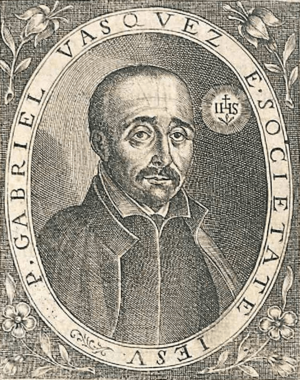Gabriel Vásquez facts for kids
Gabriel Vasquez (born in Belmonte, Cuenca, Spain, in 1549 or 1551 – died in Alcalá de Henares, Spain, on September 23, 1604) was a Spanish Jesuit theologian.
Life and Education
Gabriel Vasquez started his schooling in Belmonte. Later, he moved to Alcalá to study philosophy. He joined the Society of Jesus, also known as the Jesuits, on April 9, 1569. The Jesuits are a religious order within the Catholic Church known for their focus on education and scholarship.
After joining the Jesuits, he continued his studies in theology in Alcalá. Theology is the study of religious faith, practice, and experience. He even defended his final thesis in a public discussion.
Vasquez also taught moral theology. He taught for two years in Ocaña, then two more years in Madrid. He also taught for some time in Alcalá. Even though he was not yet 30 years old, he was asked to teach in Rome at the Roman College, a famous Jesuit school. Before leaving for Rome, he made his final vows in Belmonte.
He stayed in Rome for six years. After that, he returned to Alcalá. He taught theology there until he died. People at the time said he was very smart and dedicated to his work. Important people, like the Duke of Lerma, who was a close advisor to Philip III of Spain, often asked for his advice. Even Benedict XIV, a future Pope, called him a "luminary of theology," meaning a very bright and influential thinker.
Vasquez was known for knowing a lot about different ideas and authors. He was also praised for explaining things clearly. He studied the writings of Saint Augustine and Saint Thomas Aquinas very carefully.
His Ideas
Gabriel Vasquez sometimes had different opinions from other scholars of his time. Here are a few examples of his unique ideas:
- He believed that natural law is about understanding what actions are good and what actions are bad based on human reason.
- He thought that God's ideas are not the same as God's essence. Instead, they are God's knowledge of all possible creatures.
- He discussed the existence of God and seemed to agree with Saint Anselm's argument that God must exist.
- He believed that grace (God's help) is needed for people to do good things and overcome temptations. He saw grace as a gift from God.
- He also had specific ideas about Predestination, which is the belief that God has already decided who will be saved.
- In Christology, the study of Jesus Christ, he had particular views on topics like whether Christ was a servant of God or if he was commanded to die.
- He believed that the most important part of the Sacrifice of the Mass (a central Christian ceremony) happens when the Body and Blood of Christ are mystically separated during the consecration.
- He thought that in baptism, the guilt of sin might not be forgiven directly, but only the punishment for it.
- He believed that Episcopal consecration (when a priest becomes a bishop) gives a new power, but it doesn't change the priest's original character.
- In the Sacrament of Matrimony (marriage), he said that the bodies of the couple are the "matter," and their agreement to marry is the "form."
- He noticed that there were many atheists (people who don't believe in God) in his time. He thought this was partly because of Protestantism and also because some political leaders used religion just to control people.
Vasquez was seen as a rival to another famous theologian, Francisco Suárez. Vasquez even started his own "School" of thought, and his students often debated with the students of John of St. Thomas. Many modern theologians still quote his work.
Works and Writings
Gabriel Vasquez wrote many important books on theology and philosophy. Some of his main works include:
- De cultu adorationis libri tres et disputationes duae contra errores Felicis et Elipandi: This book was published in Alcalá in 1594.
- Commentariorum ac Disputationum in (partes) S. Thomae: This was a large work with eight volumes, published between 1598 and 1615. It contained his comments and discussions on the writings of Saint Thomas Aquinas.
- Paraphrases et compendiaria explicatio ad nonnullas Pauli Epistolas: This book, published in 1612, offered explanations of some of Saint Paul's letters from the Bible.
- Disputationes metaphysicae desumptae ex variis locis suorum operum: This special book, published in 1617, collected all the philosophical questions from his other works. It is considered a rare and valuable book.
Some of his original handwritten papers are kept in the National Library of Madrid.
See also
 In Spanish: Gabriel Vásquez para niños
In Spanish: Gabriel Vásquez para niños


